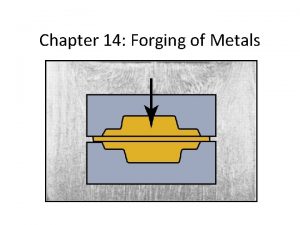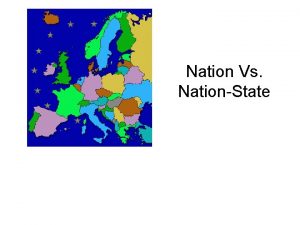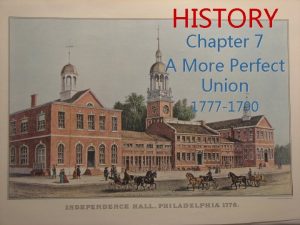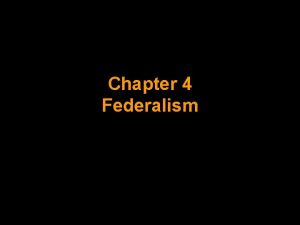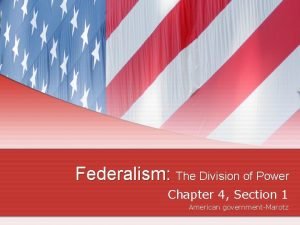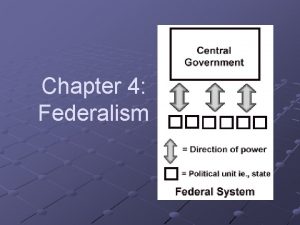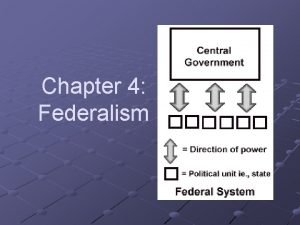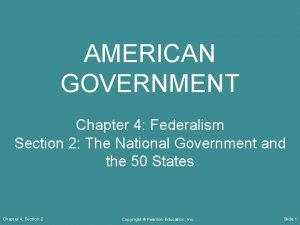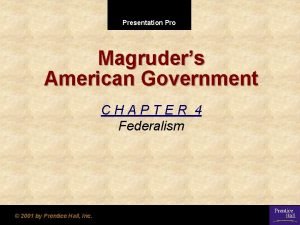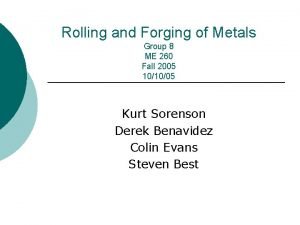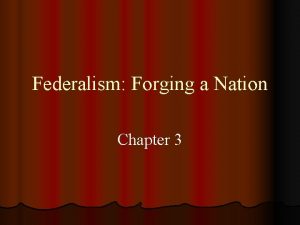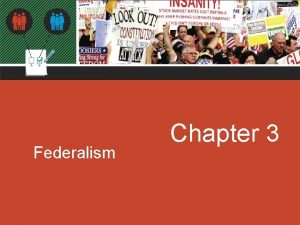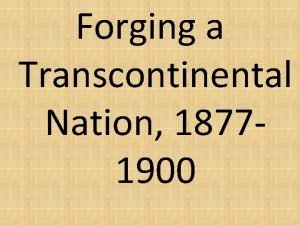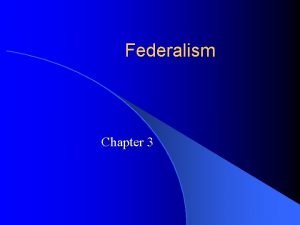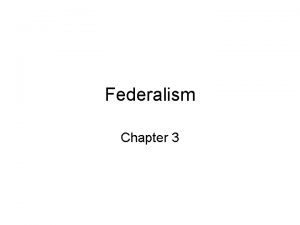Federalism Forging a Nation Chapter 3 Federalism National













- Slides: 13

Federalism: Forging a Nation Chapter 3

Federalism: National and State Sovereignty The argument for federalism Authority divided into two levels: national and regional Protects liberty Moderates government power by sharing Strengthens the union © 2015, Mc. Graw-Hill Education. All Rights Reserved. 2

Federalism: National and State Sovereignty The powers of the nation and states National: enumerated powers Seventeen powers, including measures for secure defense and stable commerce Supremacy clause National: implied powers “Necessary and proper” / “elastic” clause: make laws in support of enumerated powers © 2015, Mc. Graw-Hill Education. All Rights Reserved. 3

Federalism: National and State Sovereignty The powers of the nation and states Tenth Amendment established reserved powers: powers not delegated to the national government are reserved for the states © 2015, Mc. Graw-Hill Education. All Rights Reserved. 4

© 2015, Mc. Graw-Hill Education. All Rights Reserved. 5

Federalism in Historical Perspective An indestructible union (1789– 1865) The nationalist view: Mc. Culloch v. Maryland (1819); clear ruling in favor of national power and supremacy clause The states’-rights view: the Dred Scott decision (1857); ruling for states rights in conflict over legality of slavery © 2015, Mc. Graw-Hill Education. All Rights Reserved. 6

Federalism in Historical Perspective Dual federalism and laissez-faire capitalism (1865– 1937) Dual federalism: separation of national from state power The Fourteenth Amendment and state discretion Judicial protection of business: Supreme Court limited national power National authority prevails The economy had become a national one Brown v. Board of Education (1954) National citizenship © 2015, Mc. Graw-Hill Education. All Rights Reserved. 7

Contemporary Federalism Interdependency and intergovernmental relations Cooperative federalism: shared policy responsibilities National, state, and local levels work together Joint funding, administration, and determination of programs © 2015, Mc. Graw-Hill Education. All Rights Reserved. 8

© 2015, Mc. Graw-Hill Education. All Rights Reserved. 9

Contemporary Federalism Government revenues and intergovernmental relations Fiscal federalism: federal funds used for state programs Categorical grants: federal funds restricted to certain state programs Block grants: federal funds for state programs addressed to a general concern © 2015, Mc. Graw-Hill Education. All Rights Reserved. 10

© 2015, Mc. Graw-Hill Education. All Rights Reserved. 11

Contemporary Federalism Devolution: the idea that American federalism can be strengthened by a partial shift of power from national government to states Belief held more strongly by Republicans than Democrats Dramatically increased with Republican Revolution of 1994 Supreme Court has advanced devolution, especially in latter decades of twentieth century Devolution movement ended with presidency of George W. Bush: education and security policy © 2015, Mc. Graw-Hill Education. All Rights Reserved. 12

The Public’s Influence: Setting the Boundaries of Federal-State Power Roosevelt’s “New Deal”—jobs during the Great Depression Lyndon Johnson’s “Great Society”—increased social services in 1960 s Republican Revolution—rolled back federal authority in 1990 s Recent public backing of huge federal stimulus in 2009 © 2015, Mc. Graw-Hill Education. All Rights Reserved. 13
 Forging force
Forging force State vs nation
State vs nation Country vs nation
Country vs nation Nation state vs nation
Nation state vs nation Chapter 7 lesson 2 forging a new constitution
Chapter 7 lesson 2 forging a new constitution Chapter 4 section 1 federalism powers divided
Chapter 4 section 1 federalism powers divided Chapter 4 section 1 federalism the division of power
Chapter 4 section 1 federalism the division of power Chapter 4 federalism the division of power
Chapter 4 federalism the division of power Chapter 4 federalism
Chapter 4 federalism Chapter 4 federalism
Chapter 4 federalism Chapter 4 federalism answer key
Chapter 4 federalism answer key Chapter 4 federalism
Chapter 4 federalism Proses forging
Proses forging Upset forging advantages and disadvantages
Upset forging advantages and disadvantages
